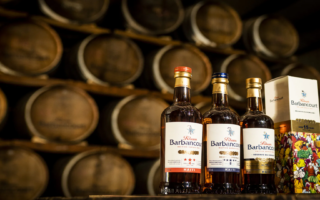Absinthe – The fairytale spirit
From Van Gogh to Oscar Wilde, artists and writers have been devotees of absinthe for decades. Ben Lerwill finds out more…
“I remember the first time I tried absinthe”, recalls distiller Dominique Rousselet. “It was during the ban, but my friend had a home-made batch. One glass – bof! I was reeling, but reeling. He told me to call home to get someone to collect me, but when I got to the phone I couldn’t remember my number. I was too embarrassed to tell him, so I pretended to have a conversation. It was all over the place, my mind. My brain was swimming. No one came for me, obviously, so eventually I had to confess to my friend that I’d completely forgotten my number. He had the bright idea of using the phone book. I could at least remember my name!” Absinthe is no stranger to being the subject of hazy anecdote. The famous ap�ritif – for which potent seems too weak an adjective – has long been bound up in layers of notoriety and controversy. For many, the word still conjures up the louche bohemian spirit of the Belle �poque, when la f�e verte (green fairy) appeared to hold every hedonist and loose-living salon in Paris under its spell. Baudelaire, Toulouse-Lautrec, Rimbaud, Modigliani and Van Gogh were known to be among its legions of creatively-minded devotees. Following its sepia-tinged heyday, however, the drink went on to receive an eight-decade production ban. Absinthe sold today as boisson spiritueuse aux plantes d’absinthe (spirit of absinthe plants) isn’t the same mind-altering brew drunk in bohemian France, although the taste remains unique. So what do we actually know about the tipple once described as making “a ferocious beast of man”?
Herbal tonic Let’s begin with the history. The drink we now refer to as absinthe was created in Val-de-Travers, a stretch of rural Switzerland on the French border, at the end of the 18th century. Initially devised as a tonic or elixir for general ill health but soon adopted by caf� crowds as a social drink, it was made from wormwood (an aromatic herb found widely in high altitude areas of Europe), macerated together with hyssop, fennel, aniseed and lemon balm (a variety of mint). This recipe, with slight variations, still forms the basis for absinthe today. It was strong – often around 70 per cent proof – relatively inexpensive, and the active ingredient in the wormwood brought on what many have depicted as a faintly hallucinogenic high. It was, in other words, a ready-made public intoxicant. By the beginning of the 19th century its popularity had grown to the extent that Swiss distillers found themselves burdened with prohibitively high export taxes. Countering this, a large number of producers moved their operations over the border to the town of Pontarlier, in the Jura area of Franche-Comt�. As the drink began finding a wider audience, an unlikely marketing coup then occurred, courtesy of the French army. Tens of thousands of colonial troops, who had used absinthe as a water purifier and dysentery preventive on campaigns abroad, returned to the boulevards and garrison towns of the nation with a taste for the green stuff, increasing its status dramatically. A new phase of absinthe consumption began. At its peak, the town of Pontarlier – today an understated, attractive little place with a handsome hilltop castle on its outskirts – played host to 25 distilleries and 111 caf�s, producing some 15 million litres annually to be carted to different parts of the country. Most famously, absinthe secured its place in the heart of artistic and literary circles, where it found no shortage of drinkers eager to souse themselves in its mildly psychoactive properties. Absinthism became a synonym for its excessive intake, and the rise of a particular kind of rakish, shambolic living. It was an era of cabarets, bohemians and benumbed drunkards. L’heure verte (the ‘green hour’) had arrived. Inevitably, something had to give. Absinthe’s omnipresence in salons and brasseries was matched by the clamour for its prohibition from anti-alcohol leagues (and, according to many, from the wine industry, whose dominance was under threat). Propaganda posters depicting the drink as a demonic influence became commonplace, and when a labourer was accused of murdering his family after drinking absinthe in 1905, the blame fell squarely at the feet of la f�e verte. Within a decade, a law banning the production and consumption of the drink had been passed unanimously by the French parliament. Today there are just two absinthe distilleries in the Pontarlier area. The aforementioned Dominique Rousselet runs one of them, the Distillerie Les Fils d’�mile Pernot (a business unrelated to Pernod with a d’). “We produce 12 kinds of absinthe today and they all have different tastes,” he says. “In some of them the aniseed is dominant, in others the fennel jumps out, and in others it’s the wormwood.” He explains that since the 1988 EU directive which allowed the production of absinthe again, the legal amount of wormwood (which contains thujone, the psychotropic ingredient responsible for absinthe’s reputation) has been restricted to a more-than-safe level. These days, then, a bottle of absinthe may still be as much as 72 per cent alcohol, but it won’t be the drink which became infamous during the Belle �poque. The taste, however, remains something special, and the drink still engenders unconcealed pride among adherents. Dominique insists on my trying several different varieties. Following 200-year-old wisdom, he allows each glass of absinthe to sit under a purpose-made slow-drip tap, diluting the spirit with a small amount of water until it turns cloudy. Purists swear that the wormwood grown in this French-Swiss border area is more aromatic than that grown elsewhere, and there are certainly heady flavours at play in each variety. The smell is a full, giddy bouquet, transporting you to another time and another place, much like a perfume. “There are three accepted ways of drinking absinthe,” he continues. “You can have it pure, drunk neat. You can have it with a few drops of water – this is actually where the green colour comes from, because absinthe itself should be clear. Or you can drip the water over a sugar cube and have it with sugar.” A further method, the flamb� technique in which the liquid is actually set alight, popular in countries such as the Czech Republic, is dismissed by Pontarlier traditionalists as a gimmick.
A family affair Receiving similarly short shrift among aficionados is pastis, another anise-based ap�ritif. It was created as a result of the absinthe ban and has gone on to occupy an almost sacred place in French culture, but to absinthe enthusiasts such as Josselin Parisot at the Distillerie Pierre Guy – which has stood in Pontarlier since 1890 – there’s little comparison. “Pastis? Pff! Don’t mention that word!” he laughs, standing in front of the distillery’s statuesque old steam-heated stills. “It’s no substitute! The absinthe from this region gets exported everywhere from Japan and Taiwan to the UK and the US. It’s a drink with real history. This distillery has been in the same family for four different generations. And there’s a fifth in waiting.” He points to a teenager helping put labels on bottles. “That’s the boss’s son. We say he’s like Ob�lix. He must have fallen in a vat of absinthe as a baby.” Both of Pontarlier’s modern-day distilleries give great scope for visitors, with tours and d�gustations offered daily. There are numerous ways of further theming a trip to the region too – the Mus�e de Pontarlier has an extensive permanent collection of absinthe posters and memorabilia, while the tourist board celebrates regional heritage with both the biennial F�te d’Absinthe, which takes place in July this year, and the annual Absinthiades festival; three days of tastings, promotions and exhibitions over the first weekend in October. Local menus, meanwhile, regularly feature absinthe-based versions of desserts such as cr�me br�l�e and sabayon. Those wishing to take the absinthe exploration even further can make the short drive over the Swiss border to French-speaking Val-de-Travers, where traditions are kept alive to the same extent. At a herb-drying shed in Boveresse I meet Nicolas Giger, president of the cross-border Pays de l’Absinthe association (he drinks three glasses before lunch on the day I’m there, so he’s clearly in the right job), and later visit the multi-award-winning La Valote-Martin distillery. “Really we need to thank the moonshiners who kept making absinthe during the ban,” says owner Francis Martin. “They were there to transmit details to the present day. Without that, we’d have nothing.” Absinthe is likely to remain heavily mythologised. Oscar Wilde famously claimed to have seen tulips growing from his legs after a heavy session, and these kind of light-hearted yarns mean there will always be a foggy romance surrounding the drink’s golden era in the late 1800s. What makes Pontarlier and the district so fascinating to visit today, however, isn’t so much the hazy mystique of the past as the fact that the absinthe story is still very much unfolding. As Nicolas Giger explains: “Absinthe, c’est une jeune fille. The f�e verte is our baby. We need to look after her.” FRANCOFILE How to get there By rail: Ben Lerwill travelled to Franche-Comt� with Rail Europe. Return fares from London to Pontarlier start at �123 per person in standard class. To book or for more information, call into the Rail Europe Travel Centre at 1 Regent Street, London SW1. Tel: 0844 848 4070 www.raileurope.co.uk By road: Pontarlier is just over six hours from the northern ferry ports.
Where to stay La Maison d’� C�t� 11 Rue Jules Mathez 25300 Pontarlier Tel: (Fr) 3 81 38 47 18 www.lamaison-da-cote.com Charmingly relaxed guest house in a refurbished period townhouse, brimming with local character and interesting design touches. Just two rooms to choose from, but both of them spacious and individual. The table d’h�te serves tasty, unfussy regional cuisine.
Where to eat C�t� Pont Maison de Cuisine 2 Rue de la R�publique 25300 Pontarlier Tel: (Fr) 3 81 46 59 53 www.cotepont.fr Town-centre restaurant specialising in home-made local dishes, with a fixed menu that changes daily.
Things to see and do Distillerie Les Fils d’�mile Pernot 18-20 Le Frambourg 25300 La Cluse-et-Mijoux Tel: (Fr) 3 81 39 04 28 www.emilepernot.fr Open Monday to Friday.
Distillerie Pierre Guy 49 Rue des Lavaux 25300 Pontarlier Tel: (Fr) 3 81 39 04 70 www.pontarlier-anis.com Open Tuesday to Friday, and Saturday morning.
Mus�e Municipal d’Art et d’Histoire Place d’Ar�on 25300 Pontarlier Tel: (Fr) 3 81 38 82 12 www.admdp.com
Distillerie La Valote-Martin 10 Rue du Quarre, CH 2113 Boveresse, Switzerland Tel: (Sw) 32 861 26 54 www.absinthe-originale.ch Tourist boards Office du Tourisme de Pontarlier 14 bis Rue de la Gare 25300 Pontarlier Tel: (Fr) 3 81 46 48 33 www.pontarlier.org
Comit� R�gional du Tourisme de Franche-Comt� Tel: (Fr) 3 81 25 08 00 www.franche-comte.org
Share to: Facebook Twitter LinkedIn Email


